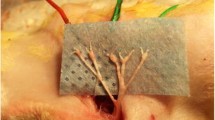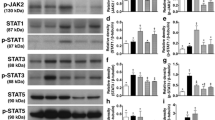Abstract
Introduction
Insulin-like growth factor 1 (IGF-1) and erythropoietin (EPO) have been reported to independently protect against ischemic spinal cord injury in rabbits. In the present study, we investigated whether the combination of IGF-1 and EPO protects against ischemic spinal cord injury in rabbits.
Methods
Animals were assigned to 1 of 4 groups (n = 6 in each): a control group (saline), an IGF-1 group (IGF-1 0.3 mg/kg), an EPO group (EPO 800 U/kg), or an IGF-1 + EPO group (IGF-1 0.3 mg/kg + EPO 800 U/kg). Spinal cord ischemia was produced by occluding the abdominal aorta for 15 min. Saline, IGF-1, and EPO were administered intravenously just after the start of reperfusion. Hindlimb motor function was assessed daily for 7 days, after which histopathological evaluation was performed. To analyze phosphorylation of signal transduction molecules, animals were assigned to 1 of the 4 groups (n = 8 in each). Spinal cord ischemia and the treatment were the same as those described above. The spinal cords were removed at 15 or 30 min after reperfusion and used to analyze phosphorylation of signal transduction molecules. Four animals served as the preischemic control, and the spinal cord was removed just before the start of ischemia.
Results
In the IGF-1 + EPO group, both neurological and histopathological outcomes were significantly improved as compared to the control group, which was consistent with the increase of Janus kinase-2 (JAK2) phosphorylation.
Conclusions
The combination of IGF-1 and EPO protects against ischemic spinal cord injury in rabbits. JAK2 might contribute to the protective effect.





Similar content being viewed by others
References
Nakao Y, Otani H, Yamamura T, Hattori R, Osako M, Imamura H. Insulin-like growth factor 1 prevents neuronal cell death and paraplegia in the rabbit model of spinal cord ischemia. J Thorac Cardiovasc Surg. 2001;122:136–43.
Celik M, Gokmen N, Erbayraktar S, Akhisaroglu M, Konakc S, Ulukus C, Genc S, Genc K, Sagiroglu E, Cerami A, Brines M. Erythropoietin prevents motor neuron apoptosis and neurologic disability in experimental spinal cord ischemic injury. Proc Natl Acad Sci USA. 2002;99:2258–63.
Smith PD, Puskas F, Fullerton DA, Meng X, Cho D, Cleveland JC Jr, Weyant MJ, Reece TB. Attenuation of spinal cord ischemia and reperfusion injury by erythropoietin. J Thorac Cardiovasc Surg. 2011;141:256–60.
Digicaylioglu M, Garden G, Timberlake S, Fletcher L, Lipton SA. Acute neuroprotective synergy of erythropoietin and insulin-like growth factor I. Proc Natl Acad Sci USA. 2004;101:9855–60.
Matsumoto M, Iida Y, Sakabe T, Sano T, Ishikawa T, Nakakimura K. Mild and moderate hypothermia provide better protection than a burst-suppression dose of thiopental against ischemic spinal cord injury in rabbits. Anesthesiology. 1997;86:1120–7.
Drummond JC, Moore SS. The influence of dextrose administration on neurologic outcome after temporary spinal cord ischemia in the rabbit. Anesthesiology. 1989;70:64–70.
Mizukami Y, Iwamatsu A, Aki T, Kimura M, Nakamura K, Nao T, Okusa T, Matsuzaki M, Yoshida K, Kobayashi S. ERK1/2 regulates intracellular ATP levels through alpha-enolase expression in cardiomyocytes exposed to ischemic hypoxia and reoxygenation. J Biol Chem. 2004;279:50120–31.
Gluckman P, Klempt N, Guan J, Mallard C, Sirimanne E, Dragunow M, Klempt M, Singh K, Williams C, Nikolics K. A role for IGF-1 in the rescue of CNS neurons following hypoxic–ischemic injury. Biochem Biophys Res Commun. 1992;182:593–9.
Reinhardt RR, Bondy CA. Insulin-like growth factors cross the blood–brain barrier. Endocrinology. 1994;135:1753–61.
Sakanaka M, Wen T-C, Matsuda S, Masuda S, Morishita E, Nagao M, Sasaki R. In vivo evidence that erythropoietin protects neurons from ischemic damage. Proc Natl Acad Sci USA. 1998;95:4635–40.
Brines ML, Ghezzi P, Keenan S, Agnello D, de Lanerolle NC, Cerami C, Itri LM, Cerami A. Erythropoietin crosses the blood–brain barrier to protect against experimental brain injury. Proc Natl Acad Sci USA. 2000;97:10526–31.
Nagamizo D, Tsuruta S, Matsumoto M, Matayoshi H, Yamashita A, Sakabe T. Tight glycemic control by insulin, started in the preischemic, but not postischemic, period, protects against ischemic spinal cord injury in rabbits. Anesth Analg. 2007;105:1397–403.
Shirasawa Y, Matsumoto M, Yoshimura M, Yamashita A, Fukuda S, Ishida K, Sakabe T. Does high-dose opioid anesthesia exacerbate ischemic spinal cord injury in rabbits? J Anesth. 2009;23:242–8.
Kirken RA, Rui H, Malabarba MG, Farrar WL. Identification of interleukin-2 receptor-associated tyrosine kinase p116 as novel leukocyte-specific Janus kinase. J Biol Chem. 1994;269:19136–41.
Miura O, Nakamura N, Quelle FW, Witthuhn BA, Ihle JN, Aoki N. Erythropoietin induces association of the JAK2 protein tyrosine kinase with the erythropoietin receptor in vivo. Blood. 1994;84:1501–7.
Zong CS, Chan J, Levy DE, Horvath C, Sadowski HB, Wang LH. Mechanism of STAT3 activation by insulin-like growth factor I receptor. J Biol Chem. 2000;275:15099–105.
Yadav A, Kalita A, Dhillon S, Banerjee K. JAK/STAT3 pathway is involved in survival of neurons in response to insulin-like growth factor and negatively regulated by suppressor of cytokine signaling-3. J Biol Chem. 2005;280:31830–40.
Ehrenreich H, Hasselblatt M, Dembowski C, Cepek L, Lewczuk P, Stiefel M, Rustenbeck HH, Breiter N, Jacob S, Knerlich F, Bohn M, Poser W, Ruther E, Kochen M, Gefeller O, Gleiter C, Wessel TC, De Ryck M, Itri L, Prange H, Cerami A, Brines M, Siren AL. Erythropoietin therapy for acute stroke is both safe and beneficial. Mol Med. 2002;8:495–505.
Acknowledgments
This study was supported by a Grant-in-Aid for Scientific Research (C) (No. 21591974) from the Japan Society for the Promotion of Science.
Conflict of interest
The authors declare no conflicts of interest.
Author information
Authors and Affiliations
Corresponding author
About this article
Cite this article
Utada, K., Ishida, K., Tohyama, S. et al. The combination of insulin-like growth factor 1 and erythropoietin protects against ischemic spinal cord injury in rabbits. J Anesth 29, 741–748 (2015). https://doi.org/10.1007/s00540-015-2031-y
Received:
Accepted:
Published:
Issue Date:
DOI: https://doi.org/10.1007/s00540-015-2031-y




